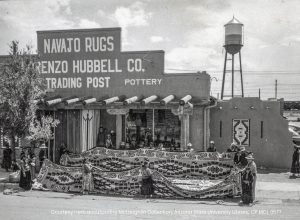La Posada owners Allan Affeldt and Tina Mion spent a decade rescuing the huge Hubbell-Joe Rug.
The magnificent Hubbell-Joe Rug is on display at Winslow’s Affeldt Mion Museum. An exhibit of the 86-year-old rug opened Sept. 2 at the museum, housed in the restored train depot at La Posada Hotel.
At 21 feet 4 inches by 32 feet 7 inches, it was the largest known Navajo rug for 40 years until the slightly larger Big Sister Rug was completed in 1977. The Hubbell-Joe Rug is sand colored with red and black designs and patterns from ancient pottery.
Museum visitor Susan Radtke of Sun City West said she was “blown away” by the enormity and beauty of the Hubbell-Joe Rug. Radtke appreciated the complexity of the textile since she took classes and learned to weave.
“Weaving is so hard,” she said. “Dressing the loom is very difficult, but weaving is pure joy.”
La Posada owners Allan Affeldt and Tina Mion spent a decade rescuing the Hubbell-Joe Rug from obscurity, unraveling its history and finding a large enough space in which to display it properly.
“Even the Heard Museum didn’t want it because it was too big,” Affeldt said of the 695-square-foot rug.
Affeldt and Mion have continued to build on their legacy of renovating La Posada and fostering the arts in Winslow. They also renovated and operate the historic Plaza and Castaneda hotels in Las Vegas, New Mexico. Now they’ve brought back a cultural treasure to Winslow as a museum centerpiece.
In 2012, Affeldt tracked down and bought the Hubbell-Joe Rug in Flagstaff for an undisclosed sum. A Winslow businessman’s grandsons inherited the rug and stored it in a wooden box in a pickup truck with a camper shell.
A decade earlier, the rug has been appraised at $470,000, Affeldt said. “It was in surprisingly good condition. If the rug went to auction it would probably bring $1 million because there’s simply nothing like it.”
The Navajo rug’s origin and well-traveled history from coast to coast symbolically add color and texture to the precisely woven textile.
It was commissioned in 1932 by Lorenzo Hubbell Jr. to lure Route 66 travelers to his Winslow trading post. This was another roadside attraction – but far more highbrow – than the World’s Largest Ball of Twine.
“Ultimately, this was created as a marketing tool,” said Lori Bentley Law, museum creative director. “It was helping Winslow at a time during the Great Depression. People weren’t stopping in Winslow. They weren’t going to the stores. This was a tool to try to bring people and it has come full circle and now it’s an added attraction to Winslow.”
Hubbell engaged Julia Joe to weave the rug with help from her family and the Navajo community of Greasewood, northeast of Holbrook. Sam Joe built a 30- by 40-foot stone building to house a very large loom.
Community members pitched in to shear 60 white and 18 black sheep. It took two years to process the wool – dying, carding and spinning it. Daughter Emma helped with that while sister Lillie helped her mother for long days of weaving the rug for three years.
The rug was completed in 1937 and the Joes delivered it to Hubbell. But the world’s largest Navajo rug was simply too big to be easily displayed at the Winslow trading post.
Hubbell loaned it out in 1939 for the Gallup Inter-Tribal Exhibition. Two years later, he died at age 58. Brother Roman continued running the family business. The senior Lorenzo Hubbell (1853-1930) started trading with the Navajos in 1876 and, with his sons, operated as many as 30 trading posts. He was also influential in the designs and styles of rugs created by Navajo weavers.
The road show for the Hubbell-Joe Rug took it across the United States for 30 years. It was displayed at an International Travel Show in New York, New York World’s Fair, Los Angeles County Fair, Arizona State Fair and Heard Museum in Phoenix.
In 1968, the rug was a backdrop for an Indian education summit at Northern Arizona University led by Sen. Robert F. Kennedy and Sen. Paul Fannin of Arizona.
As business declined after World War II, Roman Hubbell sold the family’s Winslow trading post in 1949 to local businessman Kyle Bales. That included the Indian arts inventory and Hubbell-Joe Rug.
Bales’ daughter, Patricia, inherited the rug when her father died in 1959. She later passed it on to her sons.
Displaying the Hubbell-Joe Rug was a challenge for the Affeldt Mion Museum. But Winslow artist John Suttman created a cantilevered wall that enhances the viewing experience by tilting up one-third of the rug, with two-thirds lying flat.
“I think it’s really a spectacular exhibit,” said Law, museum creative director. “We’re so proud of it and so happy to see the [Joe] family’s reaction to it.”
Close to 80 members of the Joe family got a preview of the Hubbell-Joe Rug exhibit in August. It’s unclear how much Lorenzo Hubbell Jr. paid the Joe family to weave the rug, but descendants told Law the family was fairly compensated.
Affeldt and Mion donated the rug to the Winslow Arts Trust for the Affeldt Mion Museum.
The museum is open daily from 9 a.m. to 5 p.m. Admission is $5.
Mary Walker, a Gallup weaving teacher who created a conservation plan for the rug, said the rug is in good shape, despite its travels and less-than-ideal handling.
“I’ve seen Navajo textiles woven from the 1840s and ‘50s and they’re still going strong,” Walker said. “Can it last another 100 years? Oh, I think so.” FBN
By Peter Corbett, FBN
Photo courtesy of the Herb and Dorothy McLaughlin Collection at the Arizona State University Library: The Hubbell-Joe Rug is displayed in this undated photo at Winslow’s Hubbell Trading Post, which is now the city’s visitor center.





